Traveling to Hau Thao Village: All Things You Need To Know
Where is Hau Thao Village?
Hau Thao Village is about 30 minutes from Sapa. This tranquil village is accessible via a route that meanders through mountains and terraced rice fields. The journey to this tranquil village offers a picturesque glimpse into the heart of rural Vietnam that many travelers seek.
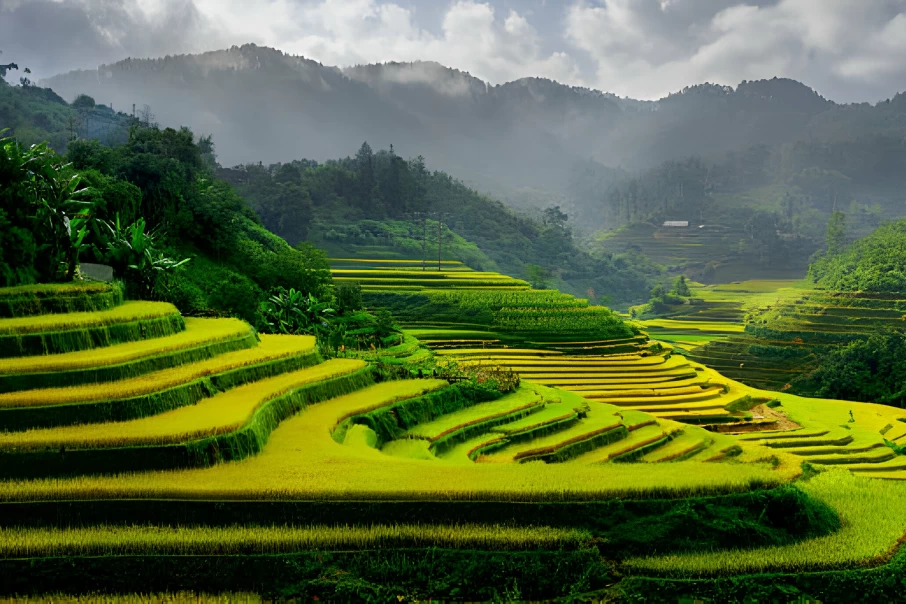
Hau Thao Village is near Sapa
The route to Hau Thao Village winds through some of northern Vietnam's most stunning natural scenery. As you leave the bustling streets of Sapa behind, the landscape transforms into a serene expanse of mountains that seem to roll endlessly into the horizon.
One of the most captivating sights along the way is Sapa's famous terraced rice fields. These agricultural marvels are a testament to the ingenuity of the local farmers, who have carved out a living from the steep mountainsides for centuries. Depending on the season, these terraces can be seen in various stages of growth, from the watery mirrors of the planting season to the golden waves of harvest time.
Who lives in Hau Thao Village?
The inhabitants here are primarily the Black Hmong people. They’re one of the many ethnic groups in Vietnam, each with its own unique traditions, language, and attire, but the H’mong in Hau Thao stand out for their strong connection to the land and their ancestral ways.

The population is predominantly composed of Black H’mong
The Black H’mong culture is vibrant and deeply rooted in agriculture and handicrafts. Their relationship with the earth is reflected in their farming practices, which are in harmony with the natural cycles of the land. They cultivate rice, maize, and vegetables on the terraced fields that are a signature feature of the region, using techniques passed down through generations.
Traditional weaving and embroidery are other cornerstone aspects of H’mong culture. The villagers, particularly the women, are skilled artisans, creating intricate textiles that are both a form of artistic expression and a means of livelihood. The art of indigo dyeing is also practiced, giving their fabrics a distinctive deep blue color that has become synonymous with H’mong attire.
Hau Thao Village Weather: When to Visit?
Sapa Easy Trekking 3 Nights
- Depart Time:Daily
- Starts/Ends:Hanoi/Hanoi
- Tour type:Private Tours
- Travel Style:Nature & Adventure, Family Tours
- Activities:Trekking and Hiking, Sightseeing Tours, Countryside and village visits tours
- Suitable for:Solo, Family, Group, Couple
- Age range:1 To 90 Years
- Operated in:English, French, Spanish, German, Italian
I think September and October are the best months to visit Hau Thao Village. This period marks the harvest season with a variety of rice terraces that are in full glory.

It is recommended that you visit Hau Thao Village in September and October
In April and May, the weather is pleasantly warm, and the skies are clear, providing perfect conditions for trekking and exploring the surrounding landscapes. The rice fields are lush and green, starting their cycle of growth, which adds a vibrant splash of color to the scenery.
If you don't mind hotter weather, June or August is a good opportunity to see the village in full bloom. The summer months bring a different rhythm to village life, with various local fruits ripening and an abundance of greenery.
However, if you're seeking a cooler climate, visiting from November to March would suit you. The village takes on a mystical appearance with the occasional fog that blankets the hills. Though the weather can be chilly, it offers a serene and peaceful atmosphere, ideal for those looking to escape the hustle and bustle of city life.
What to Explore in Hau Thao Village?
During your brief stay in Hau Thao village, there are a couple of activities you must experience to explore the area's rich cultural and natural heritage. Here are five top recommendations to make the most of your visit.
Trekking
Trekking through Hau Thao Village is an adventure that blends physical challenge with the reward of unparalleled natural beauty. The trekking trails range from easy walks that are perfect for beginners to more demanding routes that challenge even the most experienced hikers.
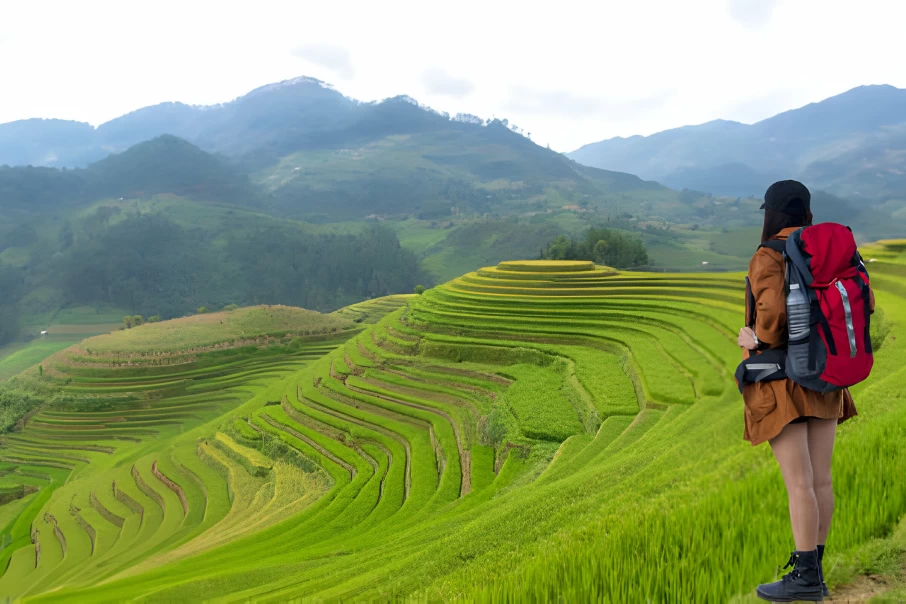
Trekking around Hau Thao village
Each trail has its own unique allure. Some trails take you through gentle hillsides, offering leisurely walks amidst the beauty of nature, while others ascend steep terrain, leading to breathtaking viewpoints.
The trails often lead through local H'mong communities, providing a unique opportunity to observe and interact with the indigenous people and their way of life. You might come across villagers working in the fields, children playing along the paths, or artisans crafting traditional textiles.
The area around Hau Thao Village is also a haven for biodiversity. As you trek through different habitats, don’t forget to keep an eye out for the region's wildlife, including various bird species, butterflies, and perhaps even the occasional glimpse of larger mammals like monkeys. The flora is also impressive, with numerous species of orchids and other endemic plants.
Cloud Hunting
Cloud hunting in Hau Thao Village, most prominent in the early morning or late afternoon hours, provides an unparalleled opportunity to witness the majestic dance of clouds as they envelop the mountainous terrain.
At the heart of cloud hunting is the pursuit of the moment when clouds cascade over the landscape like a flowing river of mist. This natural spectacle occurs due to the geographical and climatic conditions of Hau Thao Village, situated at a high elevation in Vietnam's northern mountains. The temperature differences between the air at these heights and the warmer air from the valleys below cause moisture to condense and form clouds.
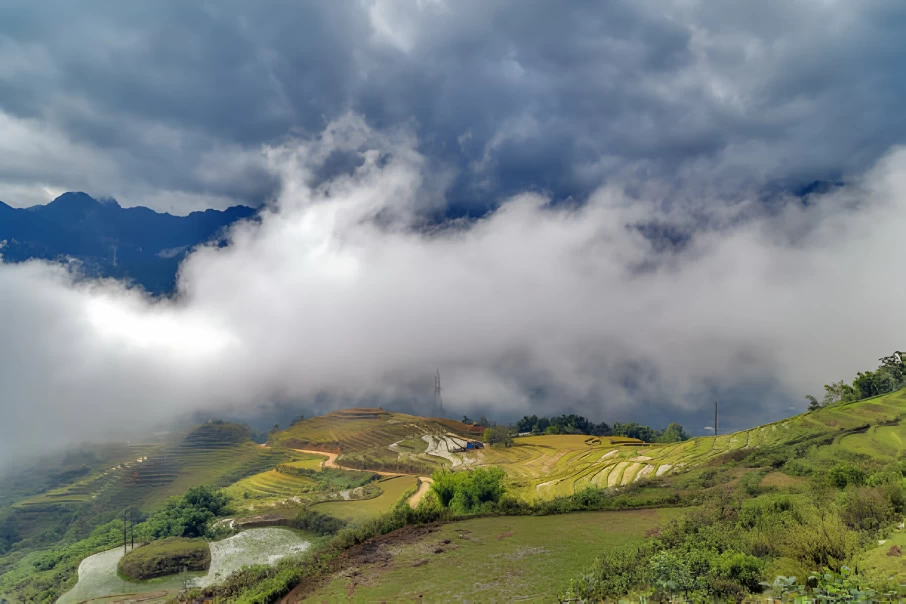
Don't miss the cloud-hunting opportunity
To fully enjoy cloud hunting, you should dress in layers since temperatures vary significantly from the base to higher elevations. Don't forget to bring a reliable camera to capture the fleeting beauty of the clouds. Furthermore, having a flashlight, water, and some snacks can make the experience more comfortable and enjoyable.
It is recommended to trek a bit higher into the mountains to spots less frequented by tourists, which can yield the most breathtaking views. Local guides can be invaluable in this regard, as they know the area's patterns and can lead you to the best vantage points for the day's conditions.
Rice Terrace Viewing
Constructed on steep mountain slopes, the rice terraces minimize soil erosion and maximize water retention, which is crucial for rice cultivation. Each terrace is a carefully shaped contour that captures rainwater, creating a cascading irrigation system that benefits the entire community.

Admire the majestic rice terraces
After planting, the fields are filled with water, turning them into reflective mirrors that catch the sky's changing hues. As the rice stalks grow, the terraces transform into a verdant sea of greens, ranging from the palest lime to the deepest emerald. Come harvest time, the fields shift to golds and yellows, creating a stunning contrast against the backdrop of the bamboo forests and the blue skies above.
And about timing your visit, the planting season in spring (usually April to June) offers cooler weather and the chance to see the terraces filled with water. Meanwhile, the harvest season in late September to October presents the terraces in their golden splendor.
Homestay Experience
Choosing a homestay over conventional hotel accommodations has a direct positive impact on the local economy. It provides a source of income for families and helps to sustain traditional lifestyles in the face of modernization pressures. It's a responsible travel choice that promotes cultural preservation and economic empowerment.
Living with a H'mong family in Hau Thao Village allows guests to observe and participate in the rhythms of rural life. You’ll have the opportunity to wear traditional H'mong attire, learn a few phrases in the H'mong language, and understand the significance of their intricate textile patterns, which often tell stories or symbolize cultural beliefs.
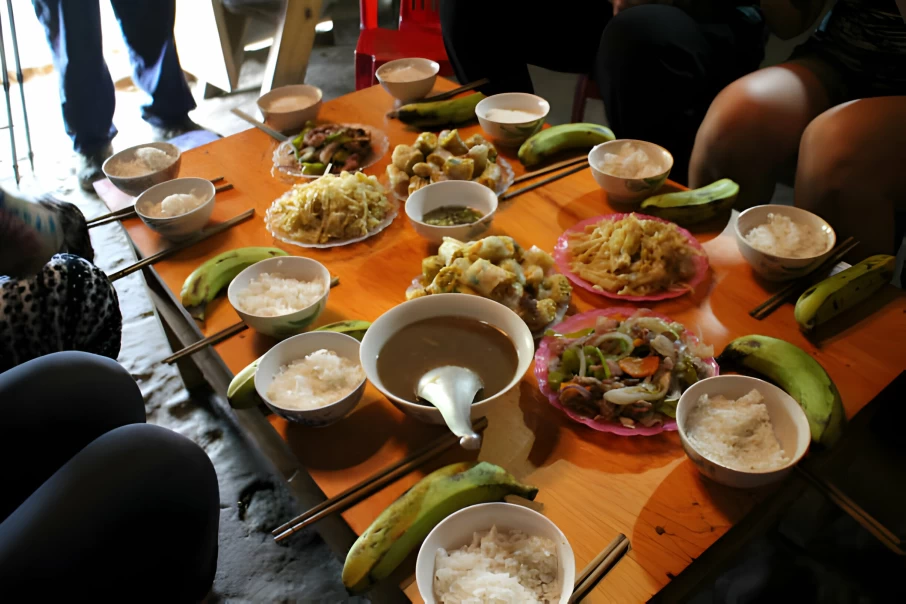
A friendly meal with the locals
Interestingly, host families often involve guests in their daily activities, such as cooking, farming, and handicrafts. Cooking with the family is a highlight, where you can learn to prepare traditional dishes using locally sourced ingredients. What’s more, depending on the timing of your visit, you might witness or participate in local festivities.
Craft Workshops
The H'mong people are renowned for their skills in textile arts, particularly weaving and embroidery. These techniques are deeply embedded in their cultural identity, with motifs and patterns that carry meanings and tell stories of their history and beliefs. In a weaving or embroidery workshop, you'll sit alongside local artisans, learning the basics of their craft, from setting up a loom to executing traditional stitches.
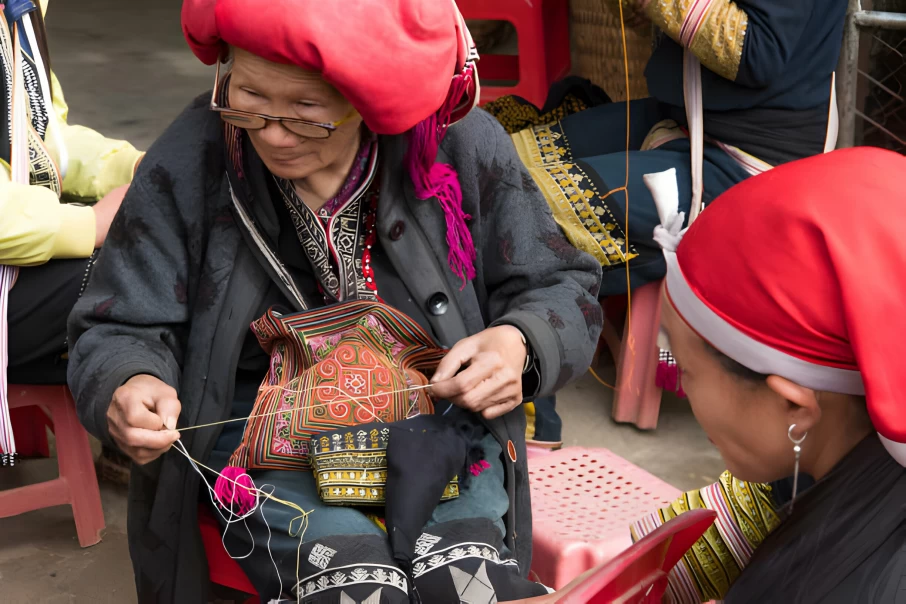
An embroidery workshop in Sapa
Silver jewelry also plays a significant role in H'mong culture, often used in traditional attire and ceremonies. In Hau Thao, skilled silversmiths craft intricate pieces that showcase the artistry and finesse of their craft. A silverwork workshop allows you to observe these artisans at work, learn about the symbolism behind various designs, and try your hand at basic techniques.
By participating in a craft workshop, you directly contribute to the preservation of traditional skills and provide economic support to local artisans. What’s more, the items you create or purchase at these workshops serve as meaningful souvenirs, each with its own story and connection to the time you spent in Hau Thao.
What to Do & Not to Do (Taboos) in Hau Thao During Your Visit?
Here are guidelines on what to do and what not to do during your visit to ensure a respectful and enjoyable experience for both visitors and residents.
Things to Do
Respect Local Customs: You should take time to learn about the local traditions and customs. Showing respect can also enhance your interactions with the villagers.
Support Local Artisans: It is good to purchase handmade crafts and textiles directly from local artisans. This not only provides you with a unique souvenir but also supports the local economy.
Participate in Guided Tours: You should opt for guided tours led by locals. This can offer deeper insights into the community’s way of life and help avoid unintentional disrespect of local norms.
Ask Permission Before Photographing: Always ask for permission before taking photos of people, their homes, or religious sites. This shows respect for their privacy and culture.
Dress Modestly: When visiting the village or any sacred sites, dress conservatively out of respect for local sensibilities.
Learn Basic Local Phrases: Learning a few phrases in the local language can go a long way toward showing respect and enhancing your interaction with the community.
Things Not to Do (Or Even Taboos)
Do Not Give Money to Children: Instead of giving money directly to children, consider supporting local schools or community projects. Giving money can encourage a cycle of dependency and truancy.
Avoid Public Displays of Affection: Public displays of affection are generally frowned upon in the local culture, so it's best to be conservative in this regard.
Do Not Enter Homes Uninvited: Respect the privacy of the locals. Do not enter their homes without an invitation or explicit permission.
Do Not Wear Shoes Inside Homes: If you are invited into a home, remember to remove your shoes as a sign of respect.
Do Not Disrespect Sacred Sites: Show respect at religious or sacred sites and follow any specific local guidelines for behavior or dress code.
Do Not Litter: Preserve the natural beauty of the village and its surroundings by not littering. Always dispose of your waste properly.
How Can You Go to Hau Thao Village?
Hau Thao Village is located near Sapa, which is well connected to the capital, Hanoi. Here’s how you can make the trip from Hanoi:
Train to Sapa: One of the most popular ways to get there is by taking an overnight train from Hanoi to Lao Cai. The train journey offers a comfortable ride and scenic views, especially as you approach Lao Cai in the early morning. You can then take a bus or a taxi from Lao Cai to Sapa town. The bus ride from Lao Cai to Sapa takes about an hour.
Bus to Sapa: Direct buses from Hanoi to Sapa are available and can be a faster option than the train. The bus journey takes approximately 5 - 6 hours. Several companies operate comfortable buses with options ranging from regular seats to sleeper buses.
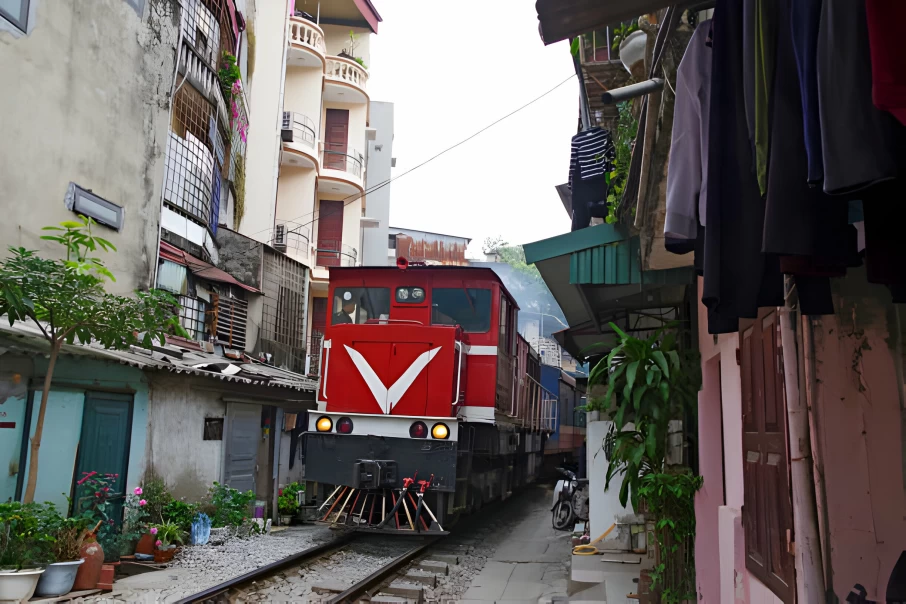
You can go to Sapa by train
Upon arriving in Sapa, you can reach Hau Thao Village by:
Motorbike Rental: Renting a motorbike in Sapa offers flexibility and the opportunity to enjoy the stunning scenery at your own pace. The ride to Hau Thao Village is relatively short and provides a chance to admire the mountainous landscapes and terraced rice fields characteristic of the region.
Local Taxi or Private Car: For those who prefer not to drive, local taxis or private cars with a driver can be arranged in Sapa. This option offers convenience and the benefit of local knowledge about the best routes and sights along the way.
Trekking: For the adventurous, trekking from Sapa to Hau Thao Village is a rewarding experience. Various routes, some more challenging than others, lead through ethnic minority villages and stunning landscapes. It’s advisable to hire a local guide who can provide insights into the local culture and ensure you take the best path.
Guided Tours: Many travel agencies in Sapa offer guided tours to Hau Thao Village. These tours often include transportation, a guide, and sometimes a meal or homestay experience. This is a great way to learn more about the local culture and history of the area.
Remember to check the current travel conditions and availability of transport options before you start your journey, as these can vary with the seasons and local regulations.
Where to Stay When Visiting Hau Thao Village?
You have a variety of accommodation options to choose from, ranging from homestays to hotels. Staying in a homestay offers a unique opportunity to immerse in the local culture and lifestyle of the Hmong ethnic group, while staying in a hotel provides more conventional comforts and amenities.
Homestays in Hau Thao Village
Local Homestays: This option is perfect for travelers looking to connect with local culture on a deeper level. Homestays often include home-cooked meals and the chance to participate in daily activities, such as farming or textile weaving.
Eco-friendly Lodges: Some lodges and guesthouses in and around Hau Thao Village focus on sustainable tourism, offering comfortable accommodations with minimal environmental impact. These lodges may provide more privacy and amenities than traditional homestays while still offering a real cultural experience.
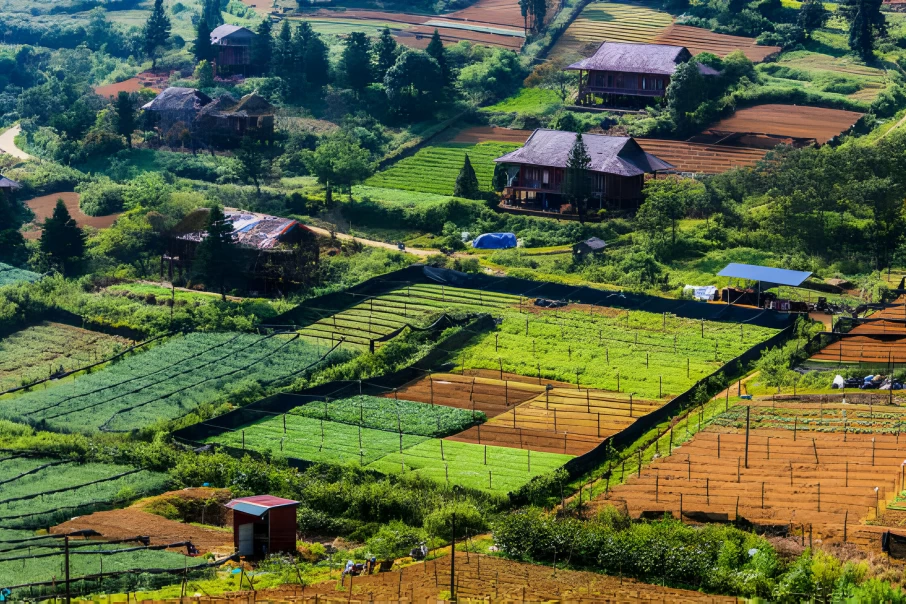
A couple of local homestays in Hau Thao village
Accommodations in Sapa Town
Budget Hotels: You can find numerous budget hotels in Sapa that offer basic comforts at affordable prices. These are suitable for travelers who prioritize savings and plan to spend most of their time exploring the outdoors.
Mid-range Hotels: These hotels often provide a good balance of comfort and value, with amenities such as en-suite bathrooms, Wi-Fi, and on-site dining. Some may offer travel services, including tours to nearby villages like Hau Thao.
Luxury Resorts: Sapa's luxury resorts offer lavish accommodations with exquisite views of the surrounding mountains and terraced rice fields. These resorts may feature spas, fine dining, and guided tours to local attractions, including Hau Thao Village.
Hostels: For solo travelers or those on a tight budget, hostels are an economical option. Many hostels in Sapa provide communal spaces and shared kitchens and organize group tours to surrounding villages and natural attractions.
Pro Tips For Traveling To Hau Thao Village
Prepare for the Weather: The mountainous region can experience sudden weather changes. Pack layered clothing to adapt to varying temperatures and rain gear to stay comfortable during unexpected showers.
Language Preparation: You can use English here, but learning basic phrases in the local language can significantly enhance your interaction with the villagers. Simple greetings, expressions of thanks, and questions can show respect for the local culture.
Cash is King: In rural areas like Hau Thao Village, cash transactions dominate. Access to ATMs can be limited, and many local vendors, homestays, and transportation services do not accept credit cards.
Travel Insurance: Given the remote nature of Hau Thao Village, ensure you have comprehensive travel insurance that covers medical emergencies and unexpected travel changes.
Health and Safety: Bring a basic first aid kit and any necessary medications, as access to medical facilities may be limited. Stay hydrated and protect yourself from the sun and insects to enjoy your exploration comfortably.
Stay Hydrated with Safe Water: It's advisable to carry a water purification method, such as water purification tablets or a portable filter, especially during treks or remote village visits.
Pack Smart: Given the village's remote location, it's wise to bring essentials that may not be readily available, such as a good-quality flashlight, extra batteries, and any specific personal items. However, be mindful of overpacking and aim to travel light.
Wrapping It Up
There are all the things you need to know before visiting Hau Thao village, Vietnam. Whether you're an avid trekker, a culture enthusiast, or simply in search of a peaceful retreat away from bustling city life, this destination should not be missed. So plan your Vietnam tours right now with Asia Tour Advisor!
You may also like

Vietnam travel tips - The pathway to a perfect trip
Traveling to a new place especially for the first time can be quite demanding, due to human anxiousness...

Is Vietnam safe to travel? An advice to upcoming travelers
It is trite knowledge that Vietnam has some of the most beautiful and breathtaking landscapes as well...

A guide to choose between Private tours and Group tours
It is often a challenge deciding between a private or a group tour, especially for first timers. Some...

Central Vietnam Itinerary - An amazing Guide to the Perfect Tour
Having on standby the right key to navigate through central Vietnam is like a dream come true especially...

South Vietnam Itinerary- A treat to an impeccable beauty
Explore the Southern part of Vietnam as you treat yourself to the best parts only. Get to experience...

North Vietnam Itinerary - A comprehensive Guide to explore the North
Northern Vietnam is a region of aesthetic sceneries and landscapes with practically fascinating cultures...

Fansipan Mountain - A solemn structure of Vietnam’s pinnacle
Explore an exciting journey with either a cable car or by hiking as you rise about 3,143 meters above...

Bay Mau Coconut Forest - A fast rising destination for tourists
Bay Mau coconut forest is a very famous ecotourism site in Hoi An as well as the whole of Vietnam. It...
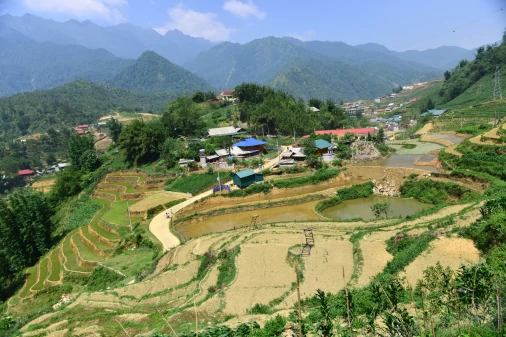
Y Linh Ho Village - Navigating The Charming North of Vietnam
Y Linh Ho village is a destination that is absolutely unique amongst the various tourist attractions...
 France
France  Spain
Spain  German
German  Italian
Italian 


 Vietnam Tours
Vietnam Tours  Cambodia Tours
Cambodia Tours  Myanmar tours
Myanmar tours  Thailand Tours
Thailand Tours  Laos Tours
Laos Tours